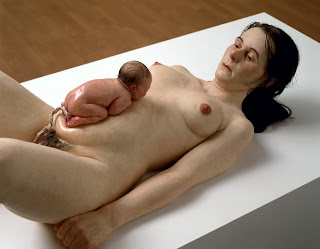Ron Mueck's sculpture and Humanism
1. Mueck's sculpture is described as 'hyper-real'. Define the meaning of this term and explain how it is evident in his work.
Taken from the web definition website, hyperreal: mode of existence in which reality and simulation are experienced as being without difference. In Ron Mueck's work it is clearly evident that he is a hyper-real artist. Once looking at his work, you are able to clearly recognize that he creates reality sculptures, the size or scale may be the only obvious change so you can distinguish it between real life and a sculpture. Every detail is slavishly created to make it as real life as possible, and as yu are able to see in the picture below, it truly is hard to distinguish the reality of it.
While researching the reasoning for Mueck to not work in life sized scale i cam across an interview explaining such, the interview by Sarah Tanguy.
She asked about how he got the idea of manipulating scale of figures , he answered 'i never made like sized figures because it never seemed to be interesting. We meet life sized people everyday.' Here we are able to make the conclusion that Mueck alters scale to raise the emotional and psychological impact. He also says ' it makes you take notice in a way that you wouldn't do with something that is just normal.
In these two sculptures of Muecks you are able to clearly see how he cleverly is able to still create such realistic people on a different scale. The pregnant women is obviously on a much larger scale as you can tell by the comparison of the lady standing next to her and the two older figures are on a smaller scale. But even by manipulating the scale the detail and skill never seem to change.
3. Define Renaissance Humanism , and identify which aspects of Humanism can be seen in Mueck's work. Note that the contemporary definition of Humanism is much broader than the Renaissance definition.
Renaissance humanism was a movement in the renaissance period. It was an intellectual and social movement, humanism is a rediscovery and re-evaluation of the aspects of classical civilization and the reapplication of these aspects to intellectual and social culture. The earliest humanists espoused a return to study of the original texts. This caused a move away from the Church as they no longer livd so closely following the regulations of the church but became more individuals. This created a huge change in the art of the time and more detail towards human movement, body language, personality was taken into more consideration. This is related to Ron Mueck's work as you are clearly able to see that he also has taken to the interest of the human body and personality and has created sculptures around it. Mueck has studied the human body and behavior
4. Research and discuss one of Mueck's sculptures that you might find challenging or exciting to experience in an art gallery. Describe the work, upload an image of the work, and explain your personal response to the work.
While i was researching for images to put on this blog i came across the sculpture by Ron Mueck 'The Women and Baby'. For me it was challenging looking at the sculpture just in a photo, in real like i believe it would be an astonishing but almost disturbing piece to view. The sculpture is a woman who has just given birth, with the baby laying on her stomach, still attached. The almost scared emotions of the woman's face are almost chilling to look at. I feel uncomfortable to look at this image for so long as i feel this is a more personal experience and should be shared between the mother and child, if i was in an art gallery looking at it i think i would feel out of place and uncomfortable as i shouldn't be there.
http://www.class.uidaho.edu/pop/Glossary.htm
http://www.sculpture.org/documents/scmag03/jul_aug03/mueck/mueck.shtml



No comments:
Post a Comment